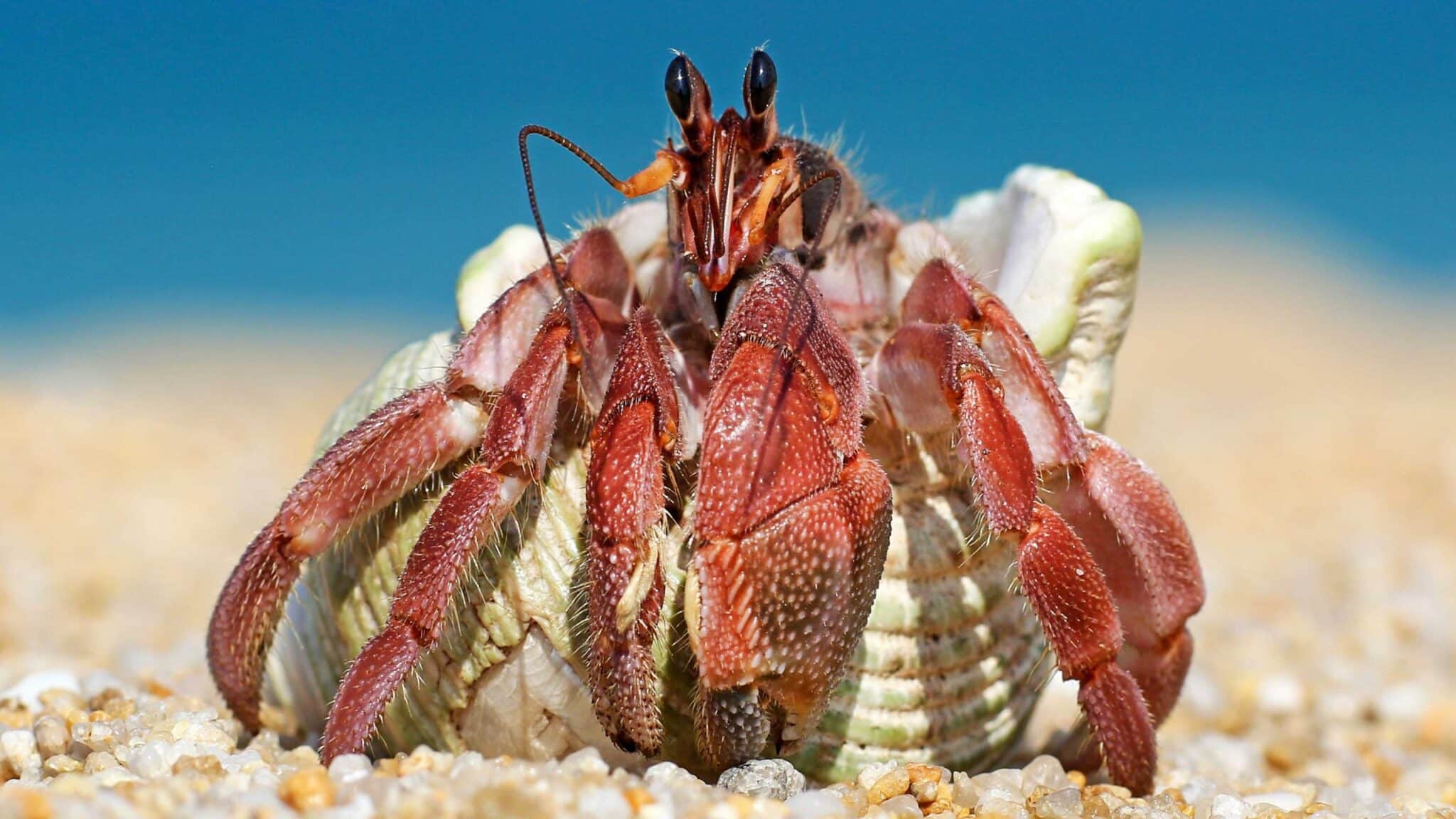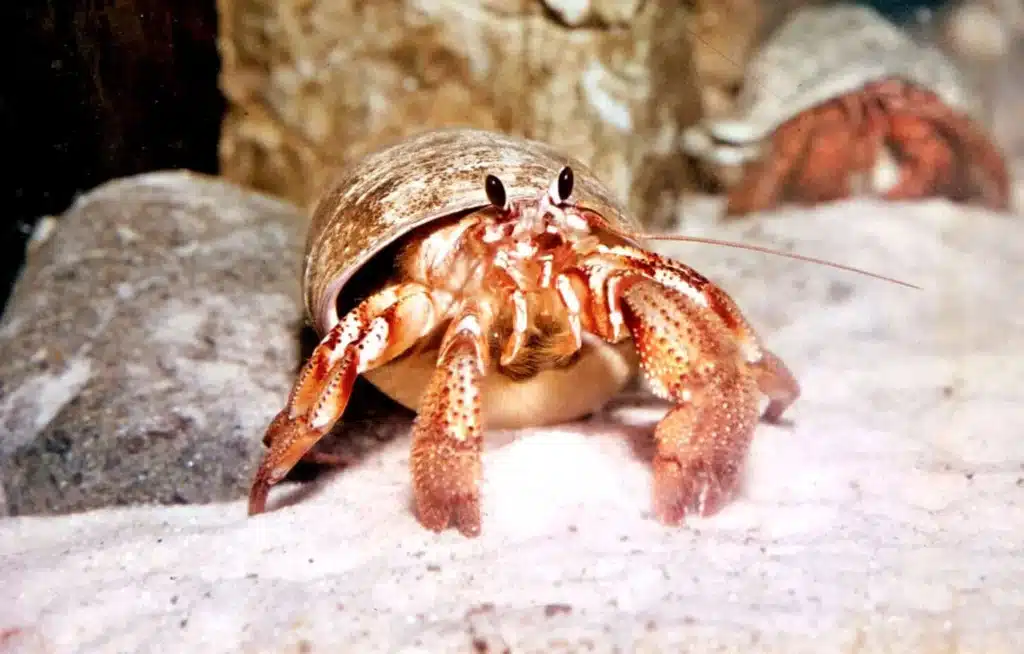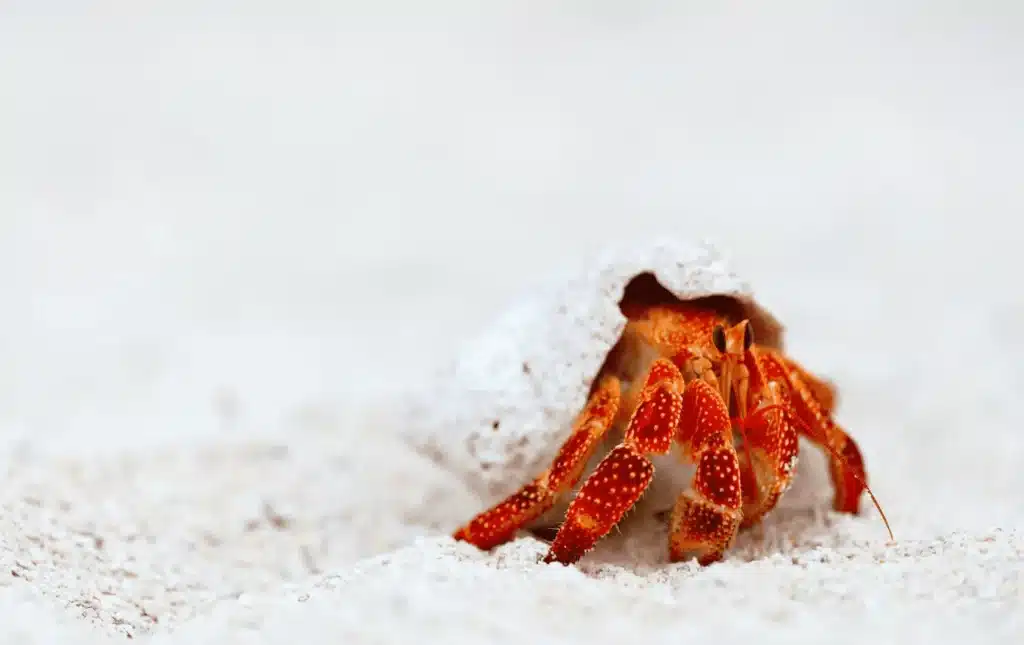How To Care For Hermit Crabs

Introduction
How To Care For Hermit Crabs: Hermit crabs, with their intriguing behavior and unique personalities, have become increasingly popular as fascinating pets. These crustaceans, often found inhabiting empty shells on tropical beaches, are captivating creatures to observe and care for. However, providing proper care for hermit crabs is essential to ensure their well-being and longevity as pets.
This guide will delve into the intricacies of hermit crab care, offering valuable insights on creating a suitable habitat, addressing their dietary needs, and maintaining their overall health. Whether you’re a novice enthusiast or an experienced crab keeper.
One of the first things you’ll discover is that hermit crabs are not solitary animals but rather social creatures that thrive in the company of their fellow crabs. This insight prompts the need for adequate space and the right companionship considerations. Additionally, their unique molting process requires careful attention to ensure their safety and comfort during this vulnerable period.
Diet plays a crucial role in their well-being, and understanding their nutritional requirements is essential for crabs growth and vitality. We will explore the varied diet of hermit crabs, encompassing both natural and commercial food options.
As we journey through the intricacies of hermit crab care, you’ll gain the knowledge and confidence needed to create a nurturing environment for these captivating crustaceans, fostering a rewarding and educational experience for both you and your hermit crab companions.

Are hermit crabs easy to take care of?
Land Hermit Crabs are very low maintenance and are easy to take care of. Normally they do not require large amounts of space and they are odorless. Hermit Crabs are not solitary animals, and it is suggested to have more than one because of their social nature.
Hermit crabs are often considered relatively easy to care for compared to some other pets, but they do require specific attention and a well-maintained habitat. While they don’t need constant interaction like dogs or cats, they do require a few key elements to ensure their well-being.
One of the primary considerations is providing a suitable enclosure with the right temperature and humidity levels. Hermit crabs are sensitive to changes in their environment, so maintaining a consistent and comfortable habitat is crucial. Regular monitoring and adjustments are necessary to achieve this.
Feeding hermit crabs is relatively straightforward, as they have a varied diet consisting of commercial hermit crab food, fresh fruits, vegetables, and protein sources. Providing a diverse menu is essential for their health and happiness.
While hermit crab care may not be overly complex, it does require attention to detail and a commitment to maintaining their environment. With the right knowledge and dedication, hermit crabs can make for fascinating and manageable pets for enthusiasts of all ages.
How do you take care of a hermit crab for beginners?
The temperature inside the enclosure should always be between 72 and 82 degrees. Use a quality tank heater or clamp lamp to maintain temperature. Hermies also need moist, humid air to breathe properly. Mist your tank with dechlorinated water to keep relative humidity between 60-80%.
For beginners, taking care of a hermit crab can be an enjoyable and educational experience. Here’s a simple guide to help you get started:
- Habitat Setup: Begin by setting up a suitable enclosure, typically a glass or plastic tank with a secure lid. Ensure it’s spacious enough to accommodate your hermit crab’s needs. Use a substrate like coconut coir or play sand to create a comfortable environment.
- Temperature and Humidity: Maintain a temperature range of 75-85°F (24-29°C) and humidity levels around 70-80%. A thermometer and hygrometer will help you monitor and regulate these conditions.
- Shells: Provide a variety of shells for your hermit crab to choose from. They need suitable shells to change into as they grow.
- Diet: Offer a balanced diet consisting of commercial hermit crab food, fresh fruits, vegetables, and protein sources like dried shrimp or fish flakes. Calcium supplements, such as crushed eggshells, are essential for their shell health.
- Water: Place both freshwater and saltwater dishes in the enclosure. Use dechlorinated water for the freshwater dish and marine aquarium salt mix for the saltwater dish. Regularly change and clean the water.
- Social Interaction: Hermit crabs are social creatures, so consider getting at least two, but make sure your tank can accommodate them comfortably.
- Molting: Hermit crabs molt to grow, which can be a vulnerable time. Ensure they have a safe, quiet place to molt and avoid disturbing them during this process.
- Cleaning: Regularly clean the habitat, removing uneaten food and waste. Spot clean as needed and do a full substrate change every few months.
Can you keep hermit crabs in fresh water?
It can take months for a hermit crab’s gills to dry out enough to cause suffocation, however, their ability to breathe will start to deteriorate well before death. Water sources. Hermit crabs require both freshwater and saltwater water sources to survive.
Hermit crabs are fascinating and unique creatures known for their habit of living inside empty shells for protection. However, when it comes to their habitat, hermit crabs are primarily found in saltwater environments, and they require access to saltwater to survive. Attempting to keep hermit crabs in a freshwater environment would not be suitable for their well-being.
Hermit crabs have adapted to life in saltwater, and they rely on it for various essential functions, such as osmoregulation and maintaining the health of their exoskeletons. A freshwater environment would disrupt these crucial processes and could lead to stress, illness, or even death for the hermit crabs.
To properly care for hermit crabs, it’s essential to provide them with a marine aquarium setup that includes access to both saltwater and freshwater. This allows them to regulate their environment and keep their shells and bodies healthy. Additionally, providing them with appropriate shells of different sizes to choose from is crucial as they will need to upgrade their shells as they grow.
Hermit crabs are creatures of the sea, and their well-being depends on the presence of saltwater in their habitat. Attempting to keep them in a freshwater environment would be detrimental to their health, so it’s essential to provide them with the proper marine setup to ensure their longevity and happiness.
What do hermit crabs eat?
Hermit crabs are pretty easygoing about what they eat. In fact, they’ll dine on just about anything they can find in the water that surrounds them, including small fish, invertebrates such as worms, plankton and any food particles that happen to be floating by.
Hermit crabs are omnivorous scavengers with a diverse diet that includes both plant and animal matter. Their feeding habits are crucial to their survival and overall well-being.
In the wild, hermit crabs are opportunistic feeders, consuming a wide range of food items they come across on the seafloor. Their diet typically consists of algae, plankton, decaying plant material, small aquatic animals like small fish, mollusk flesh, detritus, and even the occasional carrion. They have specialized mouthparts that allow them to scrape and shred food particles, making them well-equipped for a varied diet.
In captivity, it’s essential to replicate their natural diet as closely as possible to keep them healthy. Hermit crabs can be fed a combination of commercial hermit crab food, fresh fruits and vegetables (e.g., lettuce, carrots, apples), small amounts of lean protein (e.g., cooked chicken or fish), and calcium-rich sources like crushed eggshells or cuttlebone. It’s important to offer a balanced diet with a variety of food items to ensure they receive the necessary nutrients.
Additionally, providing access to clean, chlorine-free water for drinking and bathing is crucial for their well-being. Proper nutrition plays a significant role in the longevity and vitality of hermit crabs, making it important for their caregivers to offer a well-rounded and varied diet to meet their dietary needs.
Do hermit crabs need water or sand?
Shell water is important to a hermit crab. They use the shell water to hydrate their gills and will regulate its salinity (osmoregulation) based on their needs by switching between the fresh and saltwater dish. It is important that they have access to both fresh and salt water at all times.
Hermit crabs require both water and sand in their habitat to thrive and maintain their well-being. These elements serve different purposes in the lives of these fascinating crustaceans.
Water is essential for hermit crabs, and they require access to both freshwater and saltwater. Freshwater is needed for drinking and maintaining their overall health. Hermit crabs can be observed dipping their bodies into freshwater to rehydrate and clean themselves. Saltwater, on the other hand, is crucial for their osmoregulation and to maintain the health of their exoskeletons. A marine aquarium setup with saltwater pools and freshwater dishes is necessary to provide these vital resources.
Sand is equally important for hermit crabs as it serves as the substrate for them to burrow and find shelter. Hermit crabs are known for their habit of residing in empty seashells, and they also burrow in the sand for protection and to molt safely. Providing a suitable depth of clean, fine sand in their enclosure is essential to mimic their natural habitat and allow them to engage in these behaviors.
Hermit crabs need both water and sand in their environment to lead healthy and fulfilling lives. Water provides hydration and osmoregulation, while sand offers a place for shelter and burrowing. Properly maintaining these elements in their habitat is essential for the well-being of these captivating crustaceans.
Can hermit crabs be handled?
Hermit crabs are fascinating creatures, known for their unique habit of adopting discarded shells as protective homes. While they may not be traditional pets, many enthusiasts wonder if hermit crabs can be handled. The answer is yes, but with caution. These crustaceans are sensitive to touch and can be easily stressed. If you wish to handle a hermit crab, it’s important to do so gently and infrequently.
Before attempting to handle a hermit crab, it’s crucial to create a calm environment. Ensure the crab feels secure in its habitat, with ample hiding spots and a comfortable substrate. Wash your hands thoroughly to remove any scents that might be perceived as threatening. Slowly approach the crab, allowing it to become accustomed to your presence. When you do pick it up, support its entire body and avoid sudden movements.
Remember, not all hermit crabs have the same temperament. Some may be more tolerant of handling than others. It’s imperative to observe their behavior closely; signs of stress include retreating into their shell, agitated movements, or pinching. Always listen to your crab, and if it appears distressed, gently return it to its enclosure.
While hermit crabs can be handled, it should be done with respect for their delicate nature. With patience and care, you can enjoy brief interactions with these captivating creatures.
How do I choose appropriate shells for my hermit crabs?
Choosing appropriate shells for hermit crabs is crucial for their well-being and comfort. Firstly, it’s essential to understand the species-specific requirements of your hermit crabs. Different species have distinct preferences for shell shapes and sizes. For instance, purple pinchers (Coenobita clypeatus) favor round, spiral-shaped shells, while Ecuadorian hermit crabs (Coenobita compressus) prefer more elongated options.
Next, consider the size of the shell. It should be slightly larger than the crab’s current shell, providing enough room for growth and movement. Too tight a fit can lead to stress and potential health issues.
Additionally, shell openings should be smooth and free from jagged edges or cracks, which could harm the crab. Natural, unpolished shells sourced from the ocean are ideal, as they closely mimic the crab’s natural environment.
Diversity is key. Offering a variety of shells with different shapes and sizes allows your crabs to choose according to their individual preferences. Observing their behavior can give you valuable insights into which shells they prefer.
Regular maintenance is essential. Check the shells periodically for damage and replace them if needed. Providing a healthy assortment of shells will not only ensure your hermit crabs’ physical well-being but also contribute to their overall happiness and contentment in their new homes.
How do hermit crabs molt, and what should I do during this process?
Hermit crabs molt as a natural part of their growth cycle. This process is crucial for them to shed their old exoskeleton and form a larger one to accommodate their growing bodies. Recognizing the signs of molting is essential. They may become reclusive, bury themselves in substrate, or exhibit a cloudy, milky appearance prior to moulting.
During this period, it’s vital to create a stress-free environment. Ensure the tank is clean and stable, with proper humidity levels. Provide a variety of shell options nearby, as the crab will likely seek a new, larger shell after molting.
Avoid disturbing the molting crab, as this can cause severe stress and potentially harm them. Provide ample hiding places and maintain a quiet atmosphere to minimise disturbances. Additionally, resist the temptation to handle or move them during this vulnerable phase.
After moulting, the crab will be soft and delicate. They’ll need time to harden their new exoskeleton. Offer plenty of calcium-rich foods like cuttlebone or crushed eggshell to aid in this process.
Observation is key. Keep an eye on the crab’s behaviour and appearance. If there are any signs of distress or abnormalities, seek professional advice promptly.
Remember, moulting is a critical phase in a hermit crab’s life, and providing a calm and supportive environment is essential for their well-being and successful transition into a new exoskeleton.

Conclusion
Caring for hermit crabs is a rewarding and educational experience that allows you to witness the fascinating world of these unique crustaceans up close. Throughout this guide, we have explored the essential aspects of hermit crab care, from creating the right habitat to meeting their dietary needs and ensuring their overall well-being. A marine aquarium setup with saltwater pools and freshwater dishes is necessary to provide these vital resources.
By now, you understand that hermit crabs are not just simple pets but complex creatures with specific requirements. Proper housing, adequate space, and the right companions are crucial to their happiness and longevity. Moreover, maintaining a clean and safe environment, especially during their molting process, is essential to their survival.
Diet is another critical factor in hermit crab care. A well-balanced diet ensures their growth, health, and vibrant colors. Offering a variety of foods, including fresh fruits and vegetables, protein sources, and calcium supplements, contributes to their overall vitality.
Taking care of hermit crabs is a responsibility that demands dedication, but it is a journey filled with wonder and discovery. As you provide a nurturing environment and watch your hermit crabs thrive, you’ll develop a deeper appreciation for these remarkable creatures and their place in the natural world.



